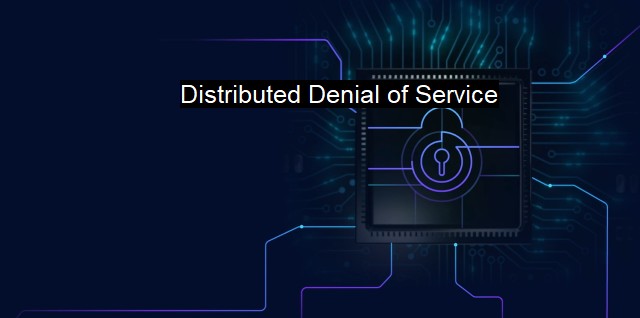What is Distributed Denial of Service?
Understanding Distributed Denial of Service (DDoS) Attacks: Threats, Tactics, and Impact on Cybersecurity
"Distributed Denial of Service", often abbreviated as DDoS, is a frequently occurring cyberthreat in the landscape of cybersecurity and network safety. This term refers to a tactical ploy executed by cybercriminals with the aim to upset regular network procedures or to render an online service unusively suspended.Cyber attackers typically carry out DDoS assaults by overwhelming a defenseless server, network, or facility with a deluge of Internet traffic. This traffic flow is frequently distributed across numerous sources - a feature that appropriately justifies the term "Distributed" in "Distributed Denial of Service". By distributing the sources of the attack, cybercriminals can successfully thwart localized defense mechanisms like Firewalls which are specifically designed to deter such attacks coming from a singular source, making defense practices exceptionally tough.
At the core of most DDoD attacks is an army of remotely controlled, infected computers otherwise known as botnets. Cybercriminals proactively gain control over these computers by infecting them with malware - a generic term given to a plethora of cyber threats such as viruses, ransomware, and spyware. Thereafter these 'bot-herders' send simultaneous requests from all these computers to the target network, causing massive traffic build-up leading to the forced collapse of network services, subsequently denying service to authorized customers.
In the cybersecurity realm, DDoS attacks can have numerous grave implications. Primarily, they can diminish the operational performance of computing systems or online mediums which drive businesses and other critical services. Consequently, veritable monetary loss can occur due to a breakdown in business processes and impaired customer experience. there is also the risk of serious damage to a company's reputation, which may deter prospective business associates or clients.
For cyber aggressors though, the DDoS attack's sweeping efficacy is tantalizing. Its simplicity and easy execution render it the preferred tool for vandals attempting to demonstrate a point, competing entities hunting for corporate advantages, or even dubious state actors wishing to disrupt critical operations of another nation. As Internet usage proliferates, the scope of DDoS attacks is all set to magnify, amplifying the importance of incorporating robust security measures.
That's where the role of antivirus systems become indispensable. The premise behind antivirus software is to actively scan, detect and eradicate malicious software in an effort to curtail instances of Active DDoS attacks. More advanced antivirus systems extend functionalities beyond casual malware identification and eradication, unleashing continuous system health checks, botnet detections, unauthorized access prevention, establishing secure firewalls, and conducting advanced threat assessments.
Insightful threat intelligence, efficient cyber risk management, and cultivating the ethos of cybersecurity awareness among device users are potent remedy measures as well. Taking care to avoid the accidental download of malignant files and updates, restricting access to non-trusted networks, installing security updates promptly and maintaining backups of critical information are some cost-effective strategies to combat DDoS assaults.
Distributed Denial of Service is a precarious cybersecurity phenomenon that strategically targets a network through overwhelming traffic surges primarily sourced from an army of infected computers or botnets. The impact it triggers extends beyond the temporary service denial, plunging secure data into potential breach threats. With the pervasiveness of Internet-delivered services, susceptibility towards DDoS attacks is poised to rocket, throwing the urgency for innovative cybersecurity mechanisms such as antivirus software, firewall maintenance, and individual awareness into sharp relief.

Distributed Denial of Service FAQs
What is a Distributed Denial of Service (DDoS) attack?
A Distributed Denial of Service (DDoS) attack is a type of cyber attack where an attacker uses multiple compromised computers or devices to overwhelm a targeted system, network or server with traffic, making it unavailable to users and bringing it down.What are the types of Distributed Denial of Service (DDoS) attacks?
There are different types of Distributed Denial of Service (DDoS) attacks, including volumetric attacks, protocol attacks, and application layer attacks. Volumetric attacks flood the network or server with a large amount of data, while protocol attacks can exploit vulnerabilities in network protocols. Application layer attacks focus on the web application layer by targeting specific components to cause specific types of damage.How can I protect my organization from Distributed Denial of Service (DDoS) attacks?
Protecting your organization from Distributed Denial of Service (DDoS) attacks involves implementing a combination of technical, organizational and human-based defenses. Technical defenses include deploying DDoS mitigation and detection solutions, while organizational defenses include creating an incident response plan and conducting regular security awareness training for employees. Human-based defenses involve promoting a security-first culture and ensuring that all staff are aware of their role in maintaining robust cybersecurity.What should I do if my organization falls victim to a Distributed Denial of Service (DDoS) attack?
If your organization falls victim to a Distributed Denial of Service (DDoS) attack, the first step is to contact your internet service provider or IT security vendor and work with them to employ mitigation techniques to stop the attack. You should also preserve any evidence related to the attack and report it to relevant authorities. After the attack, it is essential to conduct a thorough investigation and implement measures to prevent future attacks.| | A | | | B | | | C | | | D | | | E | | | F | | | G | | | H | | | I | | | J | | | K | | | L | | | M | |
| | N | | | O | | | P | | | Q | | | R | | | S | | | T | | | U | | | V | | | W | | | X | | | Y | | | Z | |
| | 1 | | | 2 | | | 3 | | | 4 | | | 7 | | | 8 | | |||||||